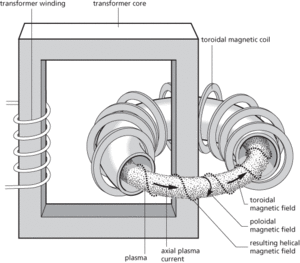A reactor in which nuclear fusion takes place with the controlled release of energy. Although thermonuclear reactors do not yet exist, intense research in many parts of the world is being carried out with a view to achieving such a machine. There are two central problems in the creation of a self-sustaining thermonuclear reactor: heating the reacting nuclides to the enormous ignition temperature (about 40 × 106 K for a deuterium–tritium reaction) and containing the reacting nuclides for long enough for the fusion energy released to exceed the energy required to achieve the ignition temperature (see Lawson criterion). The two methods being explored are magnetic containment and pellet fusion.
In the closed magnetic-containment device the fusion plasma is contained in a toroidal-shaped reactor, called a Tokamak, in which strong magnetic fields guide the charged plasma particles round the toroid without allowing them to contact the container walls. In open-ended magnetic systems the plasma is trapped between magnetic mirrors (strong magnetic fields) at the two ends of a straight containment vessel.
In pellet fusion the fuel is a mixture of deuterium and tritium in pellet form (≅ 1 mm). The fuel pellets are struck simultaneously by nanosecond pulses of high-intensity radiation from several infrared lasers. The surface of the pellet vaporizes and a shock wave is generated, which increases the pellet’s core density by up to 1000 times. The temperature of the core is raised to over 108 K. The plasma formed in this way is essentially confined to the small region of heating by its own inertia; for this reason the method is sometimes called inertial confinement. The heating occurs over such a short time (typically 1–2 nanoseconds) that the plasma has no time to disperse. Results with this type of equipment have been comparable to those achieved by magnetic confinement. At the time of writing, it is not clear whether magnetic containment or pellet fusion will be more viable in practice.

Thermonuclear reactor. Tokamak principle.
A type of reactor in which nuclear fusion takes place with the controlled release of a considerable amount of energy. While such reactors are still at the experimental stage, the main challenges are the ability to reach the very high temperatures needed that are in excess of a million degrees Celsius, and containing the reacting nuclides for a sufficient period of time to achieve the required ignition temperature. In a tokamak, powerful magnets are used to guide the charged plasma around the toroidal-shaped reactor and to prevent collisions with the walls.
- Wandewash, Battle of (22 January 1760)
- Wang Anshi (1021–86)
- Wangerripian
- Wang Pi (ad 226–49)
- Wang Yang-Ming (1472–1529)
- waning
- waning slope
- WAP
- wapiti
- Warbeck, Perkin (1474–99)
- warbiking
- warble
- Warburg, Otto Heinrich
- warchalking
- war crimes
- warcycling
- war dialler
- Ward, James (1843–1925)
- Ward, Joe Henry Jnr (1926–2011)
- wardriving
- Wardrobe
- Ward, Sir Joseph George (1856–1930)
- Ward's method
- Ward–Mellor
- ware display